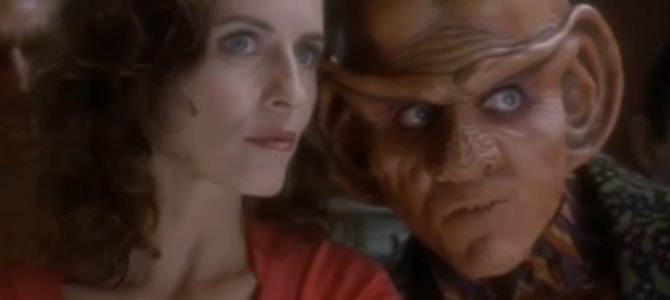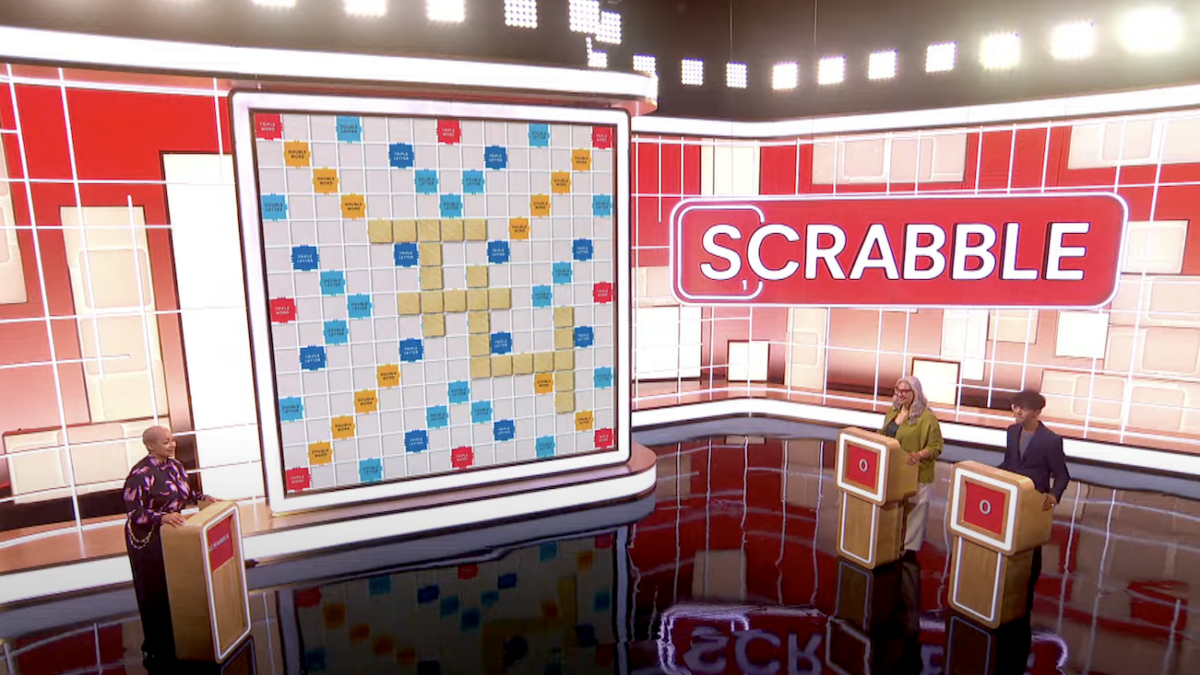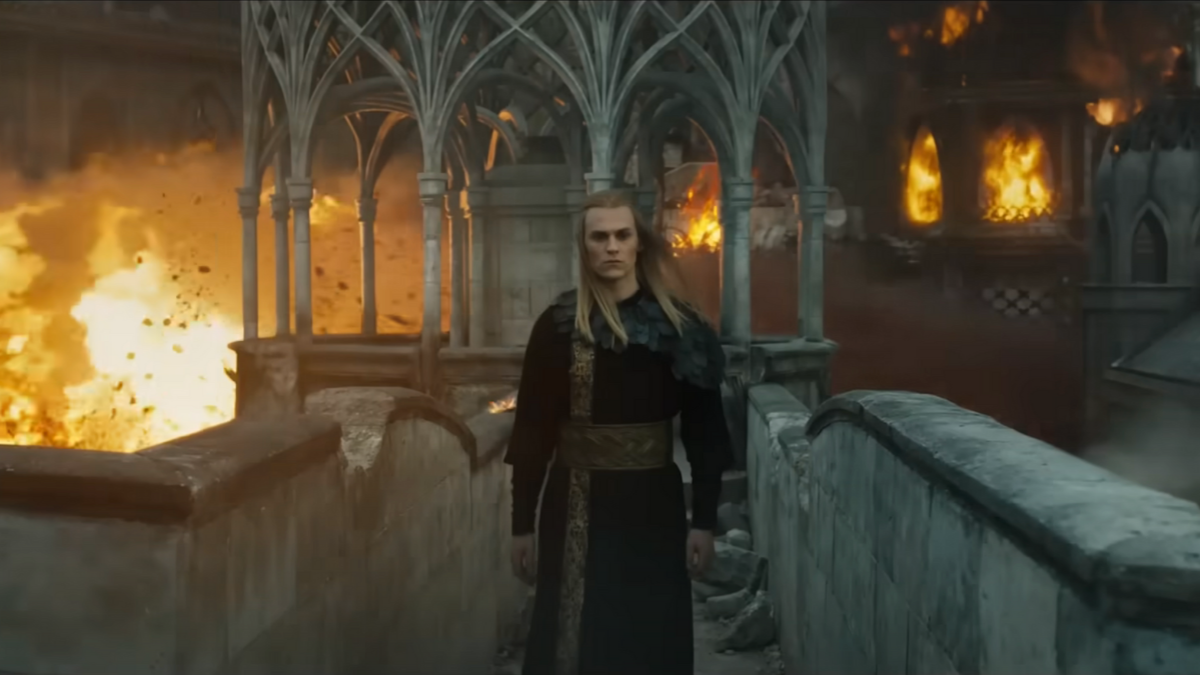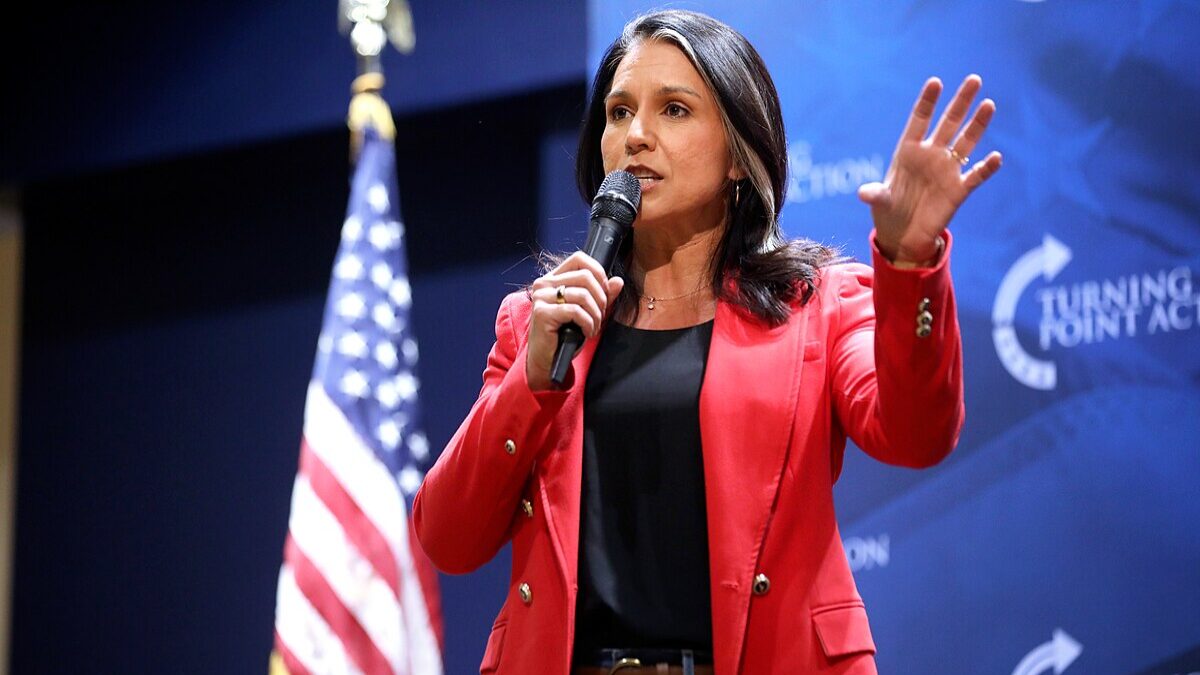
“Star Trek: Deep Space Nine’s” sixth episode, “Q-Less,” brings back two recurring characters from “Star Trek: The Next Generation” (TNG) in a plot that has the crew racing against the clock to solve a problem that could lead to the deaths of everyone on the station.
It also provides one of the first opportunities in the series to explore an alien race who will play a larger role in DS9 than in any other incarnation of the Star Trek universe: the Ferengi. How the show portrays the Ferengi says a lot about how Gene Roddenberry and his successors viewed humanity in general and capitalist humans in particular.
The two guest characters are Vash and Q. Vash (played by Jennifer Hetrick) is the more easily explained of the two: she was an archeologist of dubious morality who became the romantic interest for Captain Picard on two TNG episodes. Q is more mysterious: he is a member of the Q Continuum, a group of seemingly all-powerful beings, all of whom are named “Q.” This particular Q (played by John de Lancie) was a thorn in Picard’s side over the course of the series. “Q-Less” is his only appearance on “Deep Space Nine.”
Vash Appears on the Other Side of the Wormhole
The episode begins with Dax piloting a heavily damaged runabout back to DS9 from the Gamma Quadrant. She makes it back in one piece, but the ship suffers from an energy drain that O’Brien is at a loss to explain. Dax is also joined by an unexpected passenger, Vash, whom she picked up on the other side of the wormhole.
Vash tells the DS9 crew that she has been there for two years—far longer than the wormhole’s existence was known to anyone in the Alpha Quadrant. The presence of Vash, a human, in that remote corner of the galaxy should have been impossible, but she refuses to explain how she got there or with whom she was traveling.
The second question is answered immediately when Q appears on the station. O’Brien spots him and reports his presence to Sisko (he also meets Vash, who, typically, does not remember him.) When Vash and Q were last seen on TNG, he became fascinated with her and offered to take her with him and explore the universe together. She accepted and, as the viewer now learns, at least part of that exploration was to the other side of the galaxy.
Vash came aboard with various artifacts from the Gamma Quadrant, some of which have obvious analogs to those of more familiar cultures—a dagger, a necklace—and some of which are more mysterious. She stows them in the safes in the station’s assay office and searches for a way to dispose of them for a profit, which naturally leads her to Quark. Meanwhile, unexplained power drains like the one on the runabout begin to happen on the station.
What Vash Shares with the Ferengi
Vash’s profit motive is possibly the oddest thing about her in a world where humanity has supposedly left capitalism behind them like bear-baiting and witch-burning. This puts her out of sync with her own people and explains her familiarity with the Ferengi, who have often served as Roddenberry’s caricature of twentieth-century humanity’s greed and lust. Originally conceived as a serious enemy, their money obsession and small stature led TNG’s writers to convert them into more of a humorous nuisance species.
Ferengi became one of Roddenberry’s typically on-the-nose moral lessons. “See these people?” he seems to say, “See their obsession with wealth, their dishonesty, their misogyny, their narrow-mindedness? That’s how you (American television viewers) appear to more enlightened folk (science fiction writers).”
That was pretty much the extent of it on TNG, but post-Roddenberry, on DS9, we begin to see the writers develop the Ferengi into a more nuanced nation. They remain greedy, but, like humans, also begin to be seen as individuals with some good traits. It will become one of DS9’s strengths as a show that the writers take this joke of an enemy species and convert them into an interesting people with history and culture of their own. It will lead to a lot of interesting plotlines in episodes to come.
The Ship Is Again Threatened with Doom
In the meantime, in this episode Quark and Vash connect over a shared love for profit, and Quark organizes an auction for rich collectors of antiquities. As he does so, Q remains on the station trying to get Vash to come gallivanting around the galaxy with him again. She consistently refuses, and he uses his vast power to undermine her in petty ways, such as making Bashir fall asleep instead of going on a dinner date with her.
Sisko suspects Q is behind the power drains plaguing the station and demands that he stop. He says they are not his doing and challenges Sisko to an old-timey boxing match which, while amusing, does not really move the plot.
The auction planning continues, and Odo is, naturally, suspicious, though it is not clear what laws he thinks are being broken. Odo is on the twenty-fourth-century humans’ side in his thoughts on wealth, perhaps even more so than they are, since he has almost no possessions. Quark is baffled by this and dreams up exotic items that the constable might like to own. Yet Odo isn’t tempted.
The power drains are now somehow resulting in hull breaches, and the station is slowly being dragged toward the wormhole, which they believe will shatter the station and kill them all. There’s a lot of technobabble here, but basically, something is drawing them inexorably to their doom and the crew scrambles to track down the source of the problem.
Flawed Characters Make for Better Storytelling
Vash’s exotic goods are fetching fantastic prices at the auction, with all the bills paid in latinum, a presumably un-replicable substance that the Ferengi use as currency. Latinum was invented by the series’ writers as a workaround for the problem of currency in a world where any substance can be produced in a matter replicator.
Logically, it is a cheap out, but adding it adds the idea of money and commerce back into Star Trek, which, as we have discussed in earlier recaps, is what makes DS9 work. Looking back, it is remarkable how quickly the show overthrew Roddenberry’s core ideas about his universe. In the first six episodes, we have already seen money, religion, and conflict among the crew. And it all made for some interesting plots.
In the denouement, the most fabulous item up for auction, a weird glowing stone about the size of a cantaloupe, also turns out to be the source of the forces destabilizing the station. Just as the bidding for it gets into the economic stratosphere, Sisko orders the thing beamed into space, where it transforms into some sort of creature and “swims” through the vacuum into the wormhole and, presumably, back to wherever it came from.
The message here—that Vash’s greed almost doomed them all—momentarily convinces her to give up the hustle and work in academia. Q, prepared at last to part ways with Vash, nonetheless discourages her from going back to Earth and mentions a newly discovered ancient ruin on Tartaras V. She refuses to go there with Q, but makes it clear that she’s going there without him. As the episode ends, Bashir wakes up, having slept through the whole thing.
Here is another departure from old-style Star Trek: Vash does not learn her lesson and immediately reverts to her nasty old capitalist ways. It’s a more cynical ending, but also a more believable one. It symbolizes how “Deep Space Nine” is Star Trek coming to terms with itself.
Instead of showing the ideal of the perfected human, the New Federation Man, we have an episode starring a wonderfully old-style woman and a Ferengi who typifies all of our vices with the saintly Starfleet crew serving as supporting cast. Flawed characters make for better storytelling, and “Q-Less” is an excellent case in point.









